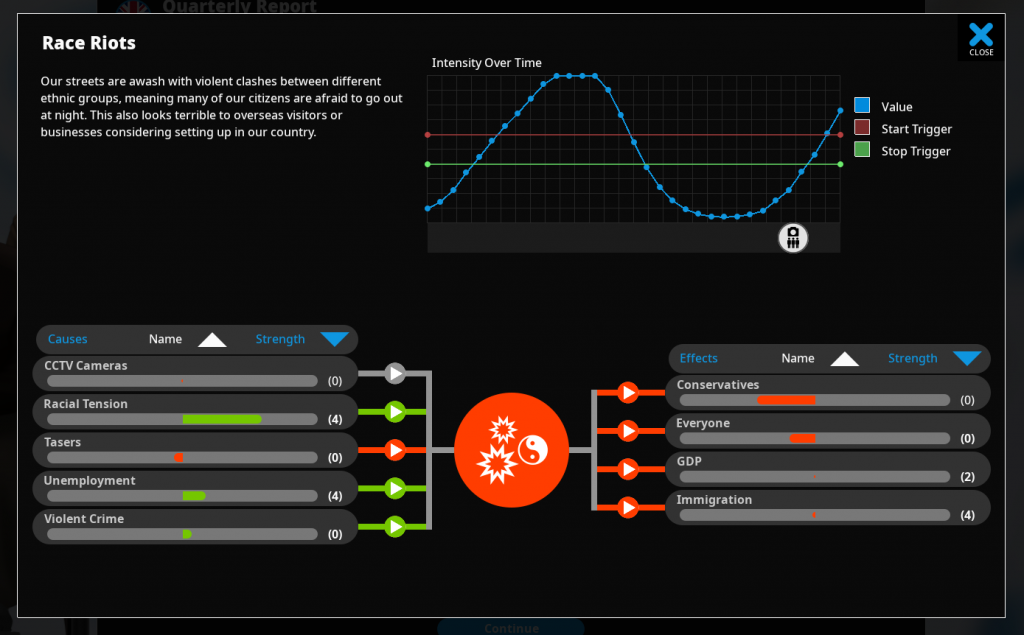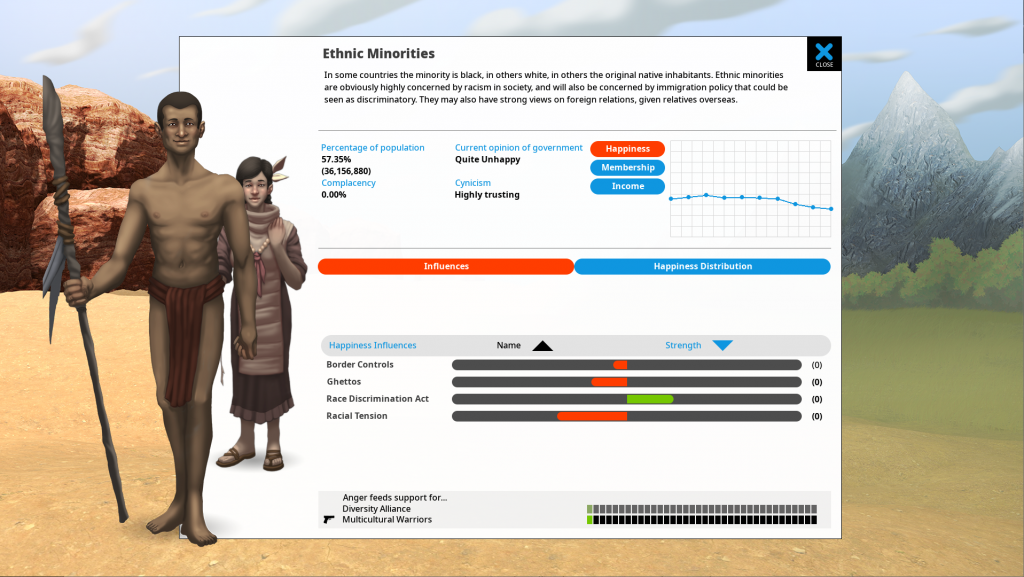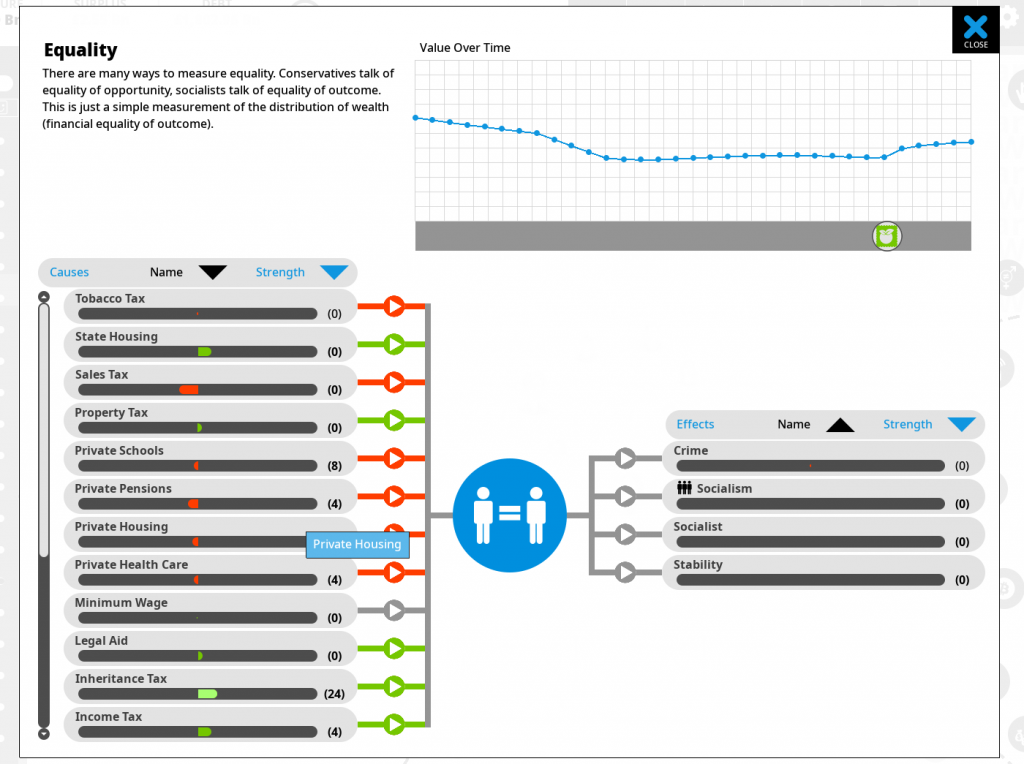My current project is Democracy 4, a game about politics, at a time when politics is…explosive to put it mildly. Right now we are in the middle of a global pandemic, there are riots going on over America, and countries all over the world have problems with fake news, extremism, extreme nationalism, gun violence and many other problems.
Democracy 4 obviously has to reflect the real world. Its a game about politics, so you cant pretend some issues do not exist because they are awkward. In fact, we are hopefully covering all political issues regardless how divisive they may be. Our game lets you outlaw homosexuality, or lets you allow gender-transition on demand. You can outlaw guns or let everyone have machine-guns. You can close all the airports, you can ban abortion, you can legalize prostitution, heroin and much more.
However, one of the topic in the game that I worry about right now, due to the current news cycle is this one:

Race riots are not new to Democracy 4, they were in D3 too, but it feels weird to experience them in-game at the same time as they are actually happening. It reminds me just how *delicate* such topics are. What are the causes of race riots? Not just in the US, or where I live in the UK, but over the whole range of countries that we hope to cover. This is hard to nail down to a few equations in a spreadsheet… Currently the main causes of them are Racial Tension, Unemployment and Violent Crime. Racial Tension itself has a number of causes, but its linked to high levels of immigration. You can mitigate it with a high standard of living, race discrimination acts and a ‘stamp out racism’ week, which is a subtle bit of social engineering.
I’m trying really hard to make a politics game, not a POLITICAL game. There is no magical code buried inside democracy 4 that tries to arrange things to preach a subtle (or not subtle) ‘racism is bad’ message. As an individual, obviously I have my own views, but as I read more and more online political discussion I find it clear that preaching never convinces anybody of anything.

Democracy 4 is supposed to be a fairly accurate simulation. In it, I’m trying to guess what the causes of events are, and the outcomes and then just represent them. You can see that race riots hit GDP, and upset everyone. They should maybe arguably affect tourism too. They will also upset conservatives, who presumably worry that their houses may get looted in riots?
In general I am a believer that logic dictates treating humans fairly and equally, and that if we follow evidence, data and science, we tend to make good decisions. That includes following maths and economics. In Democracy 4, the player will learn that race riots severely affect their re-election chances, hurt the economy, and can be expensive in terms of the policies required to get them under control (rubber bullets, tear gas, water cannons etc). Someone who wants to *win* at Democracy 4 (constant election wins) will learn not to let any one political group get too angry, and that includes ethnic minorities. Its just simple good politics in the real world too.
I think this is self evident to anybody who plays strategy games. There is always a consequence to every decision, and its good to think long term. If you are playing purely as a capitalist, you might see the need for some seemingly socialist policies just to prevent the social-breakdown and expensive consequences of vast inequality. Sure, you can pay people poverty wages, but if that means you need twice the police force to keep you safe as a result, is it really a net win?
I think its also a powerful argument in environmentalism. Sure, you can hate those hippies who hug trees and bang-on about carbon emissions, but have you SEEN the economic costs of extreme temperatures and food riots/wars/sea level rise that are the consequence of inaction? And for that matter have you seen how cheap electric cars are to run?

There is a persistent myth that Henry ford paid his workers a higher than normal salary so they could afford to buy the cars he made. Thats bullshit. I’ve read several books on ford. They were forced to hugely raise wages due to incredibly high staff turnover, but nevertheless its an interesting myth, that makes a lot of sense. Inequality has an ultimate cost, not just in security, but in terms of its negative impact on the economy.
This probably all sounds unfeeling and harsh, but I think of it as pragmatic. I believe in equal pay for women, equality for all races, and fair pay for workers *on principle*, but the most powerful argument is an argument of self interest, and the hardest argument is the ‘you should do the right thing’. There are a LOT of gun-toting, trump-supporting, right wing electric car owners now, because they finally made fast, sexy, affordable ones that people wanted, Appealing to people to buy them out of guilt never worked.
Nobody sums up this school of thought as well as quark from star trek deep space nine when he constructs an argument for ferengi women being allowed to wear clothes. He argues that if they wear clothes they will have pockets, and if they have pockets they will want to put stuff in them, so they will buy more stuff and stimulate the ferengi economy.
Its comedy, but also true.
I write all this to make a point about the style of Democracy 4 and its intentions. We cover a lot of dark, serious topics, and we do so without comment. There is no flashing symbol reminding you that RACIAL TENSION IS BAD. Adding it would be redundant, and change nobody’s opinion. Decisions in the game have consequences, and learning what those consequences are without further comment, or preaching is, I think, the best way to cover issues like this.